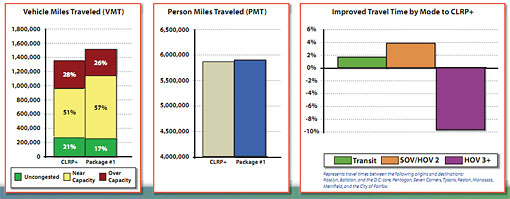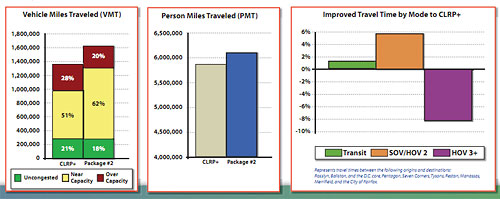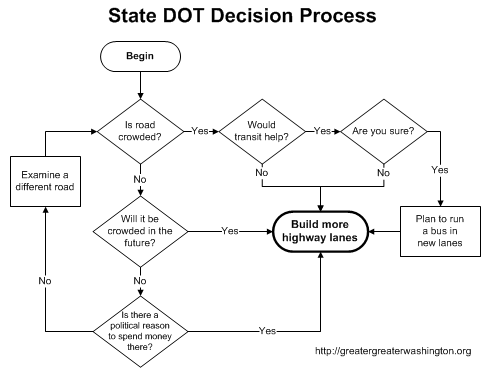VDOT ignores own data, pushes widening I-66

Photo by JoeInSouthernCA on Flickr.
When VDOT began their “multimodal” study of I-66 inside the Beltway, many assumed that this was just a formality and, regardless of what the models showed, VDOT would recommend widening the road. Turns out, that seems to be exactly what’s happening.
When the Virginia Department of Transportation (VDOT) wanted to widen I-66 in a few places, local leaders argued that they hadn’t studied the corridor thoroughly enough. Under pressure, VDOT agreed to do a study, and the results are now coming out.
According to VDOT’s own data, an option that doesn’t require widening I-66 would do more for mobility than widening it. Despite this, VDOT officials told a group of citizen and government stakeholders on Tuesday that they plan to recommend the widening option. Was this just a foregone conclusion from the start?
VDOT showed 4 “packages” of changes at 2 public meetings, along with stats for how each would likely affect travel times, traffic volumes, and more.
Package 1, which would make the existing lanes of I-66 into HOT lanes, free for vehicles with 3 or more people and tolled for 1 and 2, brings almost as much benefit as Package 2, which would add a 3rd lane on top of that. But package 1 costs about $350-650 million less.
Allen Muchnick of the Arlington Coalition for Sensible Transportation was one of the stakeholders in Tuesday’s meeting, and got to see the draft final report. It lists the following metrics for packages 1 and 2, plus another option called a “sensitivity test,” which tried only applying tolls during the peak period where I-66 is HOV-only today. Here are the key metrics. The “Pkg 1 + ST” column reflects this new option from the sensitivity test.| Metric | Pkg 1 | Pkg 1 + ST | Pkg 2 |
|---|---|---|---|
| Daily Person Miles Traveled | +40,490 (0.8%) | +318,388 (5.4%) | +267,509 (4.6%) |
| Person Throughput Measure | +5,632 (1.2%) | +27,669 (6.1%) | +24,098 (5.3%) |
| Peak Period Congested VMT | +10,726 (2.8%) | +11,230 (2.9%) | -65,164 (-16.9%) |
| Transit Ridership | +1,423 (1.1%) | +2,568 (1.9%) | +2,124 (1.6%) |
| Added Capital Cost | $33M | $33M | $345-695M |
| Added Operating Cost | $23M | $23M | $25M |
This new option, tolling at peak times, appears to move more people by both car and transit than the widening, yet saves hundreds of millions of dollars. Even without this option, it’s likely that widening the road at such cost, and with all the disruption it will cause, is not worth gaining only a few percentage points of extra movement.
The metric of “peak period congested VMT” measures the wrong thing. This is the amount of vehicle miles traveled that happen in an uncongested road. But congetion, per se, is not the problem; a short drive in traffic is better than a long drive without it. The goal is to move people, or more accurately, get people where they need to be.
There were plenty of flaws with this study from the start. This assumes, as the “baseline,” that Virginia has implemented every change in the regional Constrained Long-Range Plan (CLRP). That includes adding the 3 “spot improvements,” which would already widen I-66 in several places; and changing I-66 to HOV-3 and assuming that nobody cheats the HOV restrictions.
The CLRP also includes some projects which will help in the I-66 corridor but have no funding today, like lengthening all Metro trains to 8 cars and adding new bus service in the area. Hopefully these will happen, but there’s no guarantee.
A better study would have used today as the baseline, and looked at the CLRP changes like the “spot improvements” as some of the options. After all, if another change helps more, it’s far from too late to build that instead. We would also then be able to better see the effects of this phantom bus service, though I’m told the full report does provide more detail on the effects of these proposals.
BeyondDC reminded me yesterday about a flowchart I made back in 2009. I’ve updated it slightly:
Is the urge to widen I-66 coming from engineers who can’t shake the paving habit, or political pressure from above? If a transportation agency is unwilling to actually recommend anything other than widening, regardless of what a study shows, then that study really is the sham as people accused, and I feared, at the time, and VDOT might as well change its name to Virginia Department Of Paving Your Community.



